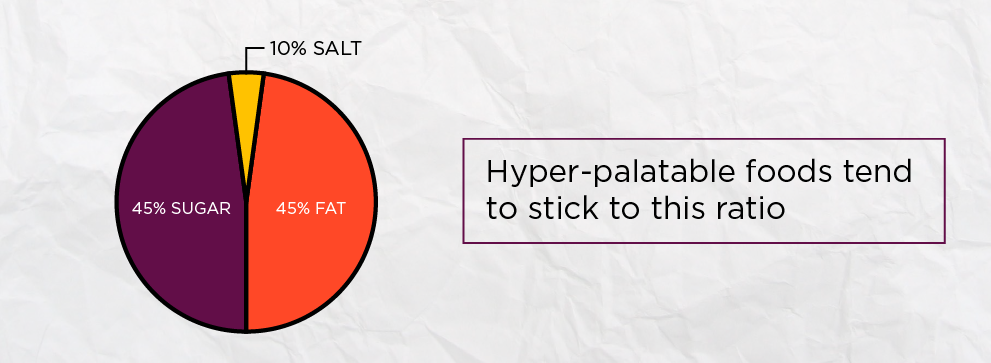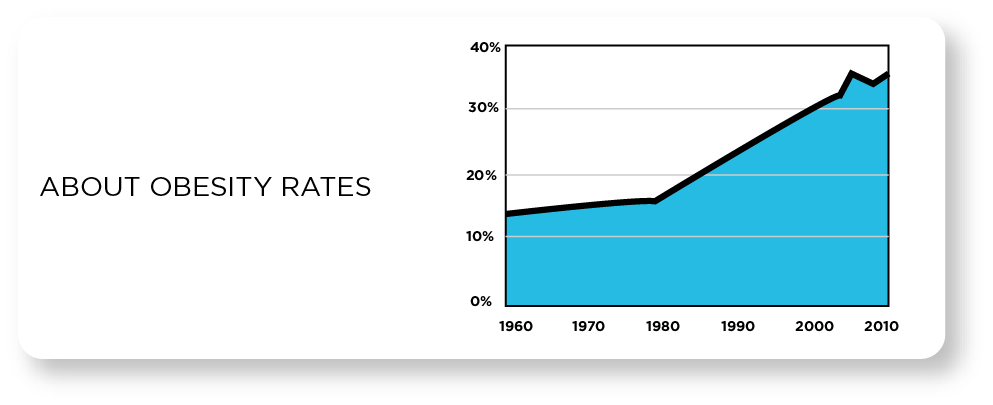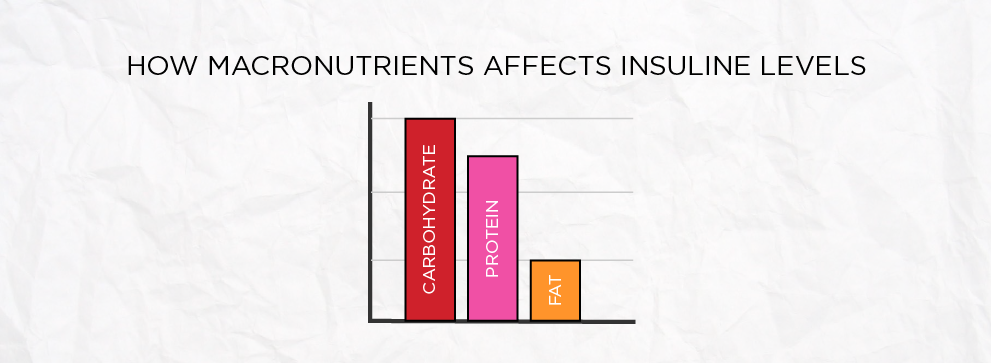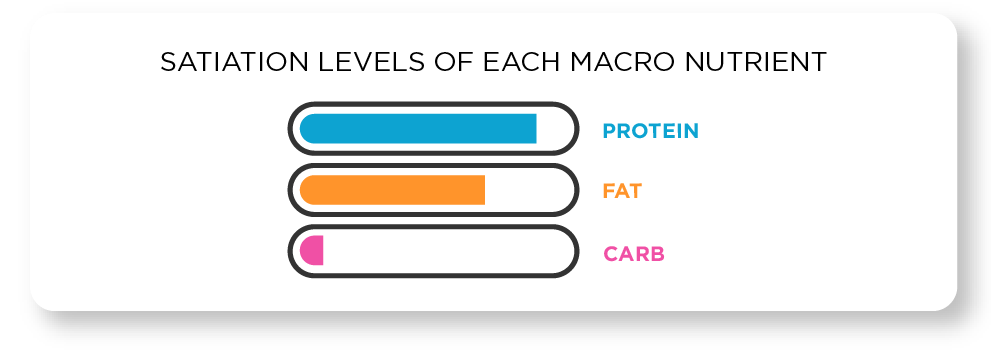
How to Use Hyper-Palatable Food to Boost Restaurant Revenue23 min read
Have you heard about the hyper-palatable food controversy?
Health experts are warning consumers to avoid these foods. But why? And why does it seem that restaurants are suddenly in the crosshairs? In this post, we take a deep dive into hyper-palatable foods, providing you with concrete steps you can take right now to dodge a bad health rap.
You’ll learn:
• What hyper-palatable foods are
• The biochemistry of these foods
• The implications for the restaurant industry
• The role of macro nutrients in health and satiation
• How to use hyper-palatable foods strategically to safeguard your business and your profits
Some of what follows is a bit technical, but don’t let that intimidate you. This is must-know information for restaurant owners in 2020 and beyond. But don’t just take our word for anything, feel free to consult the references throughout this post to verify facts on your own.
This isn’t stuff you heard in health class. As it turns out, a lot of what we’ve been told about nutrition is flat out wrong.
In the News
But first, as usual, we need to check in on the COVID-19 situation.
On the second stimulus check front, Speaker of the House Nancy Pelosi has indicated that Democrats are willing to work with Republicans. But on the whole, Democrats want to spend more, and Republicans want to spend less. This will lead to conflict as both sides seek a compromise.
It looks like it’ll take weeks of back and forth before we see a new stimulus package, but the odds of at least one more $1,200 check seem good.
However, there are rumors that Republicans want to restrict the second stimulus check to individuals earning less than $40,000. Since the Senate is currently controlled by Republicans, it is possible that they could get their way. But Democrats are likely to push back hard on any such measure.
A new piece of legislation called the Healthy Workplaces Tax Credit could be a big deal for restaurant owners.
The bill would help cover expenses of COVID-19 testing and preparedness. The proposal would provide tax relief in the form of:
• $1,000 per employee, for the first 500 employees
• $750 for the next 500 employees
• $500 for any additional employee
The proposal offers a refundable tax credit against payroll taxes. But only for 50 percent of costs incurred for COVID-19 testing. This includes:
• General antibody testing
• Protective equipment
• Extra cleaning
• Cost of procuring disinfectant
• Cost of reconfiguring work spaces to make them safer
Example:
Let’s say a 40-employee business spends $60,000 on COVID-19 related preparedness measures. They would receive a payroll tax credit for $30,000.
Be prepared to provide documentation of your expenses in case of audit.
Last up: retail sales.
Retail sales have spiked big time over the last month. This indicates increased consumer confidence in the economy. It may stem from the fact that many companies and countries are working on a vaccine, or it may be because a second stimulus is likely. Whatever the cause, it means that consumers are more willing than they were a few months ago to spend money.
You can be sure of one thing: customers stuck at home want to spend their money on food they don’t have to prepare themselves. So be ready to take advantage.
With that out of the way, let’s move on to the main event.
What Is Hyper-Palatable Food?
Have you ever heard the term hyper-palatable?
It’s a new buzzword going around health and nutrition circles, but it’s quickly leaking into the common vernacular, too. Let’s look at a definition:
Hyper-palatable: a food designed to elicit a strong dopamine release in the brain, prompting the consumer to eat more of the food than they otherwise would have.
Note the word ‘designed’ in the above definition.
From this definition, we can draw a few conclusions:
• Hyper-palatable foods must be created in a lab, test kitchen or other facility
• These foods are designed to keep the customer coming back for more
Note: throughout this post, we’ll sometimes abbreviate hyper-palatable to HP for brevity.
Here are a few examples of hyper-palatable foods you’re probably familiar with, in no particular order:
• M&Ms
• Coca-Cola
• Pop-Tarts
• Snack crackers
• Peanut butter & jelly sandwiches
• TV Dinners
But there’s another important aspect of hyper-palatable foods. These foods are processed. The closest thing in nature you’ll find to this type of food is certain nuts, milk and honey.
Whole foods, by definition, cannot be considered hyper-palatable. But they can become so depending on what you add to them.
But why are HP foods so palatable?
Well, remember the part about dopamine from the definition above? Dopamine is an important neurotransmitter. It’s involved in motivation and repeat behaviors. In this case, when you eat something you find pleasurable, your brain releases dopamine. Because these foods cause a strong dopamine release, they can prompt you to keep eating them.
Researchers aren’t sure whether HP foods cause addiction or not, but more and more health advocates seem to think so.
That could pose problems for those of us in the food service industry.
What’s more, the more often you eat HP foods, the less often you’ll eat whole foods. The reason for this is quite simple. These foods don’t just stimulate the appetite. Through the action of dopamine, the brain comes to expect the same level of stimulation from each meal you eat. But whole foods don’t stimulate the brain to the same degree that HP foods do.
See the problem?
Why It’s So Hard to Say No
There are two ways to make a hyper-palatable food:
• Add lots of salt or monosodium glutamate to a food that already contains sugar and fat
• Create a food, using pre-processed ingredients, that is a roughly equal ratio of sugar and fat, with salt added in
The second option creates a more hyper-palatable food than the first because it follows a stricter formula.

In nature, a food containing high amounts of both carbohydrate and fat is quite rare. This is why the brain values such foods so highly. In a survival situation, foods like fresh milk and walnuts can help a person put on weight. They raise insulin while providing plenty of energy. Insulin is an anabolic hormone. It helps you create body fat.
Why You Should Care
According to food expert David A. Kessler, restaurant chains like Chili’s offer primarily hyper-palatable foods. More and more, food industry critics are using words like ‘predatory’ to describe restaurants that serve this type of food. Kessler sums up HP foods this way, ‘They require little chewing and go down easily.’ The little chewing part comes from the fact that hyper-palatable foods are processed.
Processed foods tend to be made from ingredients such as industrial seed oils and highly refined flour and starches. Because these foods are structurally simple, the body digests them very rapidly. The faster the body digests a food, the faster the energy it contains hits the blood stream. Over the long term, eating these foods can lead to metabolic syndrome, which is a precursor to type 2 diabetes.
Think about the last time you ate a Snickers.
As you bite into it, your saliva begins to break down the sugars, and the fats begin to melt. Next, you bite into the caramel and the peanuts at the same time, and those flavors mix. The whole experience is designed to be extremely pleasurable. Now think of an apple, or a pineapple, even. Both are sweet, especially pineapple, but they lack the fat and other complex flavors to make them truly hyper-palatable.
Health experts criticize restaurants for having menus designed to keep customers coming back. When they do that, we tend to become defensive. After all, Nike creates sneakers that make customers want to keep coming back. Mercedes and BMW both design cars that make consumers want to keep coming back to their lots. What’s wrong with us refining our product so that we’re better positioned in the marketplace?
Well, let us play devil’s advocate for a moment.
Nike doesn’t create a product that can contribute to metabolic disease. Nor do Mercedes or BMW.
Over one-third of Americans are obese. On top of that, another 32 percent of Americans are overweight.
Since the 1970s, when Americans were cautioned to avoid fat in favor of carbohydrate, obesity rates have skyrocketed. People did start avoiding fat, but at the same time, they started eating more refined carbohydrate. Then, they started cooking at home less and…well….eating at our fine establishments more.

We’re just trying to keep our heads above water.
But yes, many of us are also contributing to a growing problem. The good news is, as we’ll see in this post, there are ways you can turn this whole hyper-palatable food problem on its ear.
What About Will Power and Consumer Responsibility?
This is a weak argument for a couple of reasons. Health experts will rip to shreds anyone trying to use it. Even the soft drink giant Coca-Cola is finding it harder and harder to peddle their ‘a calorie is a calorie’ message. Remember that HP foods are designed to be as addictive as possible. Whether food addiction itself is real or not is irrelevant. Food science is real enough, and it speaks for itself.
Remember the old Lay’s motto?
You can’t eat just one.
Food scientists know what they’re doing. What they’re doing is trying to maximize our profits.
Sure, customers should eat less junk food and exercise more. But can we really send such a message in good faith when our own menus are filled with processed foods that are high in salt, sugar and fat?
Understanding Macro Nutrients
Every dish you offer consists of three macro nutrients in some ratio. These are:
• Carbohydrate
• Fat
• Protein
Let’s take a look at each and see how they affect the human body.
Carbohydrate
A carbohydrate is a bio-active molecule consisting of oxygen, carbon and hydrogen atoms.
Once in the body, all carbohydrates break down into glucose. Glucose is one of the simplest sugars found in nature.
There are two types of carb: simple and complex.
• Simple carbohydrate. Simple carbohydrates are sugars that the body quickly breaks down into glucose. Examples include honey, fructose, table sugar, agave nectar and milk.
• Complex carbohydrate. These are long, complex strands of sugar molecules. It takes the body a bit longer to process complex carbohydrates, so they don’t affect blood sugar levels as quickly. They occur in non-starchy vegetables, tubers and other foods.
Researchers once thought that the body and brain needed carbohydrate to function. However, modern science understands this to be false. The brain does not require carbohydrate, it requires glucose. The body has two ways of obtaining that glucose:
• From carbohydrate ingested as food
• From protein
If carbohydrate is scarce, the human liver can perform a trick called gluconeogenesis. Through this process, the body breaks down excess dietary protein into glucose. Moreover, only a few cell types in the body rely on glucose. Any cell in the body that contains mitochondria can utilize fat—ketones—as an energy source as well. In fact, human babies are born in a state of ketosis, and some level of ketosis is perfectly normal and safe.
Cell types that must have glucose include:
• Red blood cells
• Certain brain cells
• Certain eye cells
All other cell types will readily utilize fat energy if they need to.
Therefore, whether we like it or not, carbohydrate is technically a non-essential macro nutrient. This doesn’t mean that carbohydrate isn’t important. Indeed, if you’re doing anything athletic or are in a survival situation, carbohydrate may be necessary for peak performance. However, it does mean that a human being can survive and indeed thrive without carbohydrate.
Consider this: the average person has between four and five grams of glucose in their bloodstream at any one time. If they ingest 150 grams of carbohydrate in a single meal—or indeed, a single beverage—their body must work hard to clear that sugar energy from the bloodstream. It does this via the hormone insulin. But over time, this clearing action can tax the beta cells of the pancreas, which can lead to metabolic dysfunction.
Carbohydrate is an important macro nutrient. The body can readily use it to meet its energy needs. However, claims that the body or brain require it are false. The science does not support this assertion. The body requires glucose, not carbohydrate. When people make the claim that the brain needs carb, what they are really saying is that carbohydrate is the most efficient way for the body to get the glucose it needs. But most efficient is not always optimal, especially if an individual is eating an overabundance of refined carbohydrate. AKA, hyper-palatable foods.
Fat
Fat is an essential macro nutrient. Your brain is mostly fat. Cholesterol—which is essential for life—is mostly fat. Your nerves are wrapped in fat. Fat provides an important cushion for your internal organs. And while your body can create adipose tissue, it cannot do so out of thin air. You must get the raw materials from food. Finally, fat is essential for the creation of certain hormones.
However, not all fats are created equal.
First things first. The evidence that saturated fat is harmful seems to have been overblown.
In the recent meta-analysis, Saturated Fats and Health: A Reassessment and Proposal for Food-based Recommendations: JACC State-of -the-Art Review, researchers conclude:
Whole-fat dairy, unprocessed meat, eggs and dark chocolate are SFA-rich foods with a complex matrix that are not associated with increased risk of CVD. The totality of available evidence does not support further limiting the intake of such foods.
The current consensus is that saturated fat from whole food sources doesn’t seem to be harmful. But saturated fat from processed foods is. Why? It’s because those processed foods contain refined ingredients like wheat flour, simple sugars and refined seed oils…and because they’re hyper-palatable. Consumers tend to eat more of them than they should for optimal health.
This is why epidemiological data seemed to vilify saturated fat for so long. Epidemiology cannot show causation, only association. People who eat processed food also tend to exercise less, smoke more and in general take poor care of themselves.
While saturated fat from whole foods may not be harmful, it does seem that trans-fat and refined seed oils from any source may be problematic. Hydrogenated oils are created by forcing hydrogen atoms into unsaturated fats. These fats have a negative impact on cholesterol profile. They raise LDL while lowering HDL. Trans fats can be found in:
• Margarine
• Shortening
• Baked goods
• Pre-made doughs
• Fried foods
Processed seed oils like rapeseed, soybean oil and canola oil are polyunsaturated fats. These fats are just fine in and of themselves. In fact, the body needs them. But the body doesn’t need them in high quantities. Polyunsaturated fats are omega-6 fatty acids. On other hand, oils from fish and some other sources provide omega-3 fatty acids. The body likes to keep these two oils in balance at a ratio of 1:1.
However, because many people get quite a bit of omega-6 fatty acids from seed oils, their ratio of omega-3 to omega-6 is off. This can lead to chronic inflammation because omega-6 oils are pro-inflammatory. The body needs to be able to mount an immune response, but not all the time. Too much omega-6 in the diet can keep the immune system on high alert, exhausting it. This can lead to joint pain and other issues.
Alternatives to industrial seed oils include:
• Avocado oil
• Coconut oil
• Olive oil
These are fruit oils, and they generally require less processing. They also tend to contain less omega-6. However, they tend to be more expensive and they’re not as shelf stable. They may also have lower smoke points.
Protein
As noted, protein can serve as a backup energy source if carb is scarce. However, its primary role in the body is as a building block for tissue maintenance. Proteins consist of amino acids, and some amino acids are essential. You must get them from diet. Therefore, it’s important that a person gets adequate protein.
Here is a list of the most protein-rich foods:
• Beef
• Poultry
• Fish
• Whole sea foods such as oysters, mussels and clams
• Cheese
• Milk
Vegetarians and vegans get their protein from a wide range of plant sources. Soy is a good option as it can provide all of the essential amino acids. But there are concerns that raw soy can cause a range of health issues. Research into these claims is ongoing.
Insulin response
Insulin is the primary anabolic hormone. As mentioned, it helps animals put on weight. Recall how a bear searches for fruit in spring and summer. It does this so that it can convert the fructose in the fruit into body fat. Humans can perform the same trick, by the way.
When you eat food, your blood insulin level goes up. But not all macro nutrients effect insulin levels the same way. It breaks down like this:
• Carbohydrate stimulates insulin release the most
• Protein stimulates insulin release about half as much
• Fat barely stimulates insulin release at all

As we’ll see, this setup has implications.
Satiation
Here’s a simple experiment you can do right now:
Go out and buy a big bag of Doritos and a pack of bacon. Eat the entire bag of Doritos. Easy, right? Come on, you know you’ve done it at least once. We all have.
But now try to eat the entire pack of bacon. It’s much harder to do, isn’t it? The bacon is quite tasty, but it’s primarily composed of fat and protein, both of which are incredibly satiating. But the Doritos do not provide the same satiation effect.
You’ve probably heard of the American Chinese Food effect. A couple walks into a Chinese food buffet and stuffs themselves. But three hours later, they’re hungry again. Why is this? It’s down to how the body reacts to carbohydrate. Recall that the body breaks processed foods down very quickly. Americanized Chinese food buffets tend to offer refined carbohydrates as their main macro. These refined carbohydrates cause the blood sugar to rapidly increase. But then, beta cells in the pancreas release insulin, which brings blood sugar back down.
But sometimes, the blood sugar dips too low, which causes the brain to go into panic mode.
The brain then signals the person to eat again. This yo-yo blood sugar effect drives overconsumption of carbohydrate. If those carbs are hyper-palatable, as is often the case in a buffet setting, the result can be massive overeating.
Summary:
In terms of satiation, we can rank the macro nutrients like this, from most satiating to least:
• Protein
• Fat
• Carbohydrate
 Eating fat and protein causes certain hormonal changes in the body that suppress appetite. Eating primarily carbohydrate does not have the same effect.
Eating fat and protein causes certain hormonal changes in the body that suppress appetite. Eating primarily carbohydrate does not have the same effect.
The hormones involved are:
• Ghrelin
• Insulin
• Glucagon
• Leptin
What’s more, a diet that is higher in fat and protein and lower in carbohydrate tends to keep blood sugar more stable. This in turn means fewer cravings.
So…now that we’re caught up on the science, how can we put this information to good use? Let’s find out.
Using Hyper-Palatable Food Strategically
In a previous post, we touched upon the importance of knowing your service story.
Put simply, your service story is:
• What you think you mean to customers
• What you aim to provide to customers
McDonald’s has a very clear service story. They want to provide fast food that has consistent quality. A Big Mac in Japan should taste the same as a Big Mac in Ireland.
A high end restaurant, on the other hand, may have a completely different service story. Their service story allows them to charge higher prices. Why? Because they provide higher quality and offer exclusivity, or status.
When pondering the facts about macro nutrients and hyper-palatable foods, consider your service story.
If providing comfort food is an important part of your service story, or brand, you may indeed need to stick to your guns when challenged by health experts. However, you should still explore sugar alternatives like aspartame and sucralose.
Did you know? Aspartame is not good for baking or hot dishes since it breaks down when heated. But sucralose is heat stable, so you can use it in banked goods.
On the other hand, what if your service story is that you provide filling meals that give your patrons plenty of energy? In that case, you may well want to reduce the carb content in your dishes in favor of fat and protein.
Let’s look at some more practical tips.
#1 Know What You Offer
The first step is to look at your current menu. You need a rough idea of the macro nutrient ratio of your dishes. If you’re like most establishments, it will look something like this:
If the carbs in your dishes are mainly coming from simple or refined carbohydrate, beware. You may come under fire for offering ‘unhealthy’ food dishes.
Consider offering lower carb alternatives or coming up with a few new recipes that rely more heavily on healthy fats.
#2 Offer Gut Busters
If you already have any gut buster dishes on your menu that are designed to make your patrons feel stuffed and happy, consider offering a low carb option. Imagine a Denny’s Grand Slam, but without the pancakes or waffles. Instead, offer more bacon and eggs. And remember: while gravy contains fat, it also contains flour, a source of carbohydrate.
A lower carb gut buster will promote a deeper feeling of fullness without a corresponding blood sugar crash. Your customers won’t need a nap or a snack two hours later. This is a subtle effect, but it’s a real effect and it can lead to repeat business.
Besides, with low carb diets like the ketogenic diet and paleo becoming ever more popular, offering a low carb option is just good business sense. Keep in mind, however, that a dish that’s higher in protein will have a higher cost, too. You may need to adjust prices accordingly.
#3 Use Protein and Fat to Create an Impression of Value for Money
In a similar vein, you can create low carb alternatives without advertising them as such. For instance, lettuce or cabbage provides a great plant-based material to hold taco ingredients. Both veggies are much lower in carb than a tortilla is. At the same time, you could add more avocado—a very healthy source of fat—and protein to the taco. The combination of lower carb and higher fat/protein will make your customer feel more satisfied after eating.
This creates a subconscious association between the dish and value for money.
Next time, the customer will be more likely to choose your low carb alternative because it makes them full longer. And since the ingredients are more expensive, you’ll naturally need to price it higher. So, over time, you can increase your profits simply by providing a healthier alternative. That’s a win-win.
After all, the tortilla offers little in the way of nutrition. It is little more than a source of glucose.
#4 Make Your Desserts Hyper-Palatable but Your Main Dishes less So
The critics can’t blame you for making your desserts irresistible, can they?

So this is where you can mix those refined sugars and starches with fat to create truly stunning treats. At the same time, consider adding more whole foods to your main dishes so that they’re less hyper-palatable. Don’t worry, less hyper-palatable doesn’t mean less desirable. Keep in mind that for the vast majority of human history, human beings were eating simple, humble foods.
Trust your chef to create tasty dishes based on healthy whole foods. Your customers will come back for them again and again.
Things to consider removing from your dishes:
• Unnecessary sauces that add sugar or unhealthy fats
• Unnecessary starches—all starches break down into glucose once in the body
• Deep frying in seed oils
• Pre-made ingredients that are little more than refined sugar and/or fat
• Shortening or margarine—use butter or lard instead if possible
In general, if you make your dishes less hyper-palatable, you make them more filling, too. This is because it generally involves removing refined carb and adding complex carb, fat and/or protein.
#5 Avoid High Calorie Drinks
In the years to come, you will start to see more and more restaurants and beverage companies coming under fire for their high calorie drinks. On the whole, the science indicates that humans should not be drinking calories. It doesn’t matter whether the sugar is coming from fruit juice, soda or sweetened coffee. Once it enters the body, the liver can convert it into fat.
For instance, orange juice was once widely seen as a health drink. But this was never based in science; it was merely a product of marketing. Fruit juice contains fructose, a simple sugar that breaks down into glucose. Too much fructose in the diet leads to weight gain because the calories it contains are often in excess of what the body needs.
It is true that fruit juice contains some micronutrients. But you can easily get those micronutrients from other foods, such as non-starchy vegetables, seafood and organ meats. Taking this into account, and given its caloric content, drinking fruit juice becomes quite questionable.
You can get ahead of the curve right now by removing some of these high calorie drinks from your menu or by offering more zero calorie alternatives.
Did you know? The evidence that sugar substitutes are harmful is quite thin. Practically non-existent, in fact. If a sugar substitute is on the market these days, you can assume it has been thoroughly tested. Aspartame, for instance, is one of the most tested man-made compounds. It does not cause adverse effects in most people.
#6 Use Sodium Strategically
Are you using more sodium or MSG than you need? You’ll likely be in the crosshairs of health food advocates sooner or later. Large amounts of sodium is necessary for the creation of a hyper-palatable food. Sodium blunts the sweetness of foods, allowing food manufacturers to put more sugar into a product. This causes the brain to have a stronger dopamine response than it otherwise would have.
Therefore, if you don’t want to be accused of creating these foods, use only the amount of sodium the recipe calls for. In other words, salt to taste. Avoiding MSG altogether is ideal, as it’s an unnecessary food additive with one purpose: to enhance flavor.
We hope this post has shed some light on the whole hyper-palatable food controversy. If it has, could you consider giving us a share? We would greatly appreciate it!



